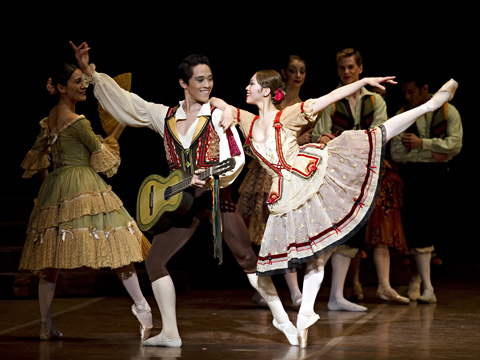
REVIVALISTS Jeffrey Cirio and Misa Kuranaga are small, light, and sparkling in a fun, if clichéd,
production. |
In the long string of ballet productions extracted from Miguel de Cervantes's novel Don Quixote, the delusional Don has become a minor character, charging into situations where he shouldn't go and causing trouble instead of good works. The one exception is the haunted version George Balanchine made in 1965. Everyone else who's mined the 17th-century tale for the ballet stage has made it a pretext for romance, rowdy comedy, and lots of dancing. Balanchine admitted a certain affinity with the hallucinating Don — he sometimes played the mimed part himself, opposite his muse, Suzanne Farrell — and maybe that's why his ballet is so strange and moving. Nothing remotely heart-wrenching occurs in the 1966 Rudolf Nureyev version, which was revived Thursday by Boston Ballet (on view at the Opera House till May 6).
Nureyev roughly followed the scenario crafted in 1869 by Marius Petipa, the 19th-century ballet master who perfected the Russian Imperial styleof classical story-ballets. Nureyev wasn't known as a choreographer, but during his reign as the king of dancers he restaged the classics in order to challenge himself with new material. Boston Ballet basked in Nureyev's glory when he set the ballet for them in 1982, not only starring in the production but taking the entire company with him on a national tour.
Like all the ballets of its vintage, but more so, Don Quixote doesn't take its story seriously. The role Nureyev coveted wasn't Don Quixote but Basilio, the young barber who courts Kitri despite her father's disapproval. Lorenzo, the father, sees a rich husband for Kitri in the preposterous person of Gamache, a bewigged and perfumed gentleman. Don't worry, Kitri and Basilio win out in the end, but not before three acts of deceptions, claptrap, and old-ballet clichés.
This can be fun if you don't mind the implausibility of the whole thing. For me, as a theatrical experience the evening lacked dramaturgical balance. Important theatrical effects and intricate plot devices get sketchy treatment. The townspeople mill around with fans and mugs of grog.
In the very first scene, where we meet the Don (guest artist Carlos Molina on opening night) and his lumpen squire (Robert Kretz), a bright follow-spot picks out the Don as he stumbles around his room, leaving Nicholas Georgiadis's detailed set and the other characters in the gloom. Lighting designer John Cuff followed the same scheme throughout, lighting the principal dancers and drabbing-down the picturesque backdrops and the flamboyant costumes of the ensemble. Only the Don's vision scene, where Kitri/Dulcinea and a corps de ballet dance a set of classical variations, is fully lit.
Nureyev's choreography engages the entire company, in Spanish-flavored, gypsy-flavored, and classical numbers. The lead couple, Jeffrey Cirio and Misa Kuranaga, are small, light, sparkling dancers, well-suited to Nureyev's fussy step-combinations. I especially liked their pas de deux at the beginning of the second act, when they were alone on stage and could express their tenderness for each other without anyone else distracting our attention.
The current revival, directed by Maina Gielgud with Amanda Eyles, seems to have made the dancing its priority; noted French ballerina and coach Monique Loudières was brought in as regisseur. In featured roles opening night, we saw Kathleen Breen Combes and Yury Yanowsky as Spanish dancers Mercedes and Espada; Rie Ichikawa and Dalay Parrondo as friends of Kitri; Artyom Maksakov as Lorenzo, the father; and Paulo Arrais as Gamache, the foppish suitor. Molina as the Don seemed to have a clear idea about his character, but the others were still working out of ballet's book of stereotypes. ^